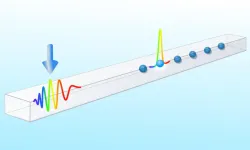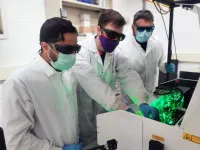(Press-News.org) University of Otago researchers have discovered one of the reasons why more than 50 per cent of people with type 2 diabetes die from heart disease.
And perhaps more significantly, they have found how to treat it.
Associate Professor Rajesh Katare, of the Department of Physiology, says it has been known that stem cells in the heart of diabetic patients are impaired. While stem cell therapy has proved effective in treating heart disease, it is not the case in diabetic hearts.
It has not been known why; until now.
It comes down to tiny molecules called microRNA which control gene expression.
"Based on the results of laboratory testing, we identified the number of microRNAs that are impaired in stem cells of the diabetic heart," Associate Professor Katare says.
"Among several microRNAs we identified that one particular microRNA called miR-30c - which is crucial for the stem cells' survival, growth and new blood vessel formation - is reduced in the diabetic stem cells. All these functions are required for stem cell therapy to be successful in the heart.
"Importantly, we also confirmed that this microRNA is decreased in the stem cells collected from the heart tissue of the patients undergoing heart surgery at Dunedin Hospital."
Researchers were able to then increase the level of the lacking miR-30c in the heart by a "simple injection".
"This resulted in significantly improving the survival and growth of stem cells in the diabetic heart," Associate Professor Katare says.
"This fascinating discovery has newly identified that impairment in the microRNAs is the underlying reason for the stem cells being not functional in the diabetic heart. More importantly, the results have identified a novel therapy for activation of stem cells in the heart using microRNA, without the need to inject stem cells, which is a time and cost consuming process."
Associate Professor Katare calls the finding "significant" and says it could help diabetes- sufferers - who are ten per cent of New Zealanders - lead a longer, quality life.
"Apart from identifying the reasons for poor stem cells function in a patient with diabetes, the novel therapy of using microRNA could change the treatment method for heart disease in diabetic individuals."
Researchers will now undertake more laboratory testing before moving on to humans.
"Our initial analysis revealed that there might be another four potential candidate microRNAs. Therefore, it is essential to test the function of those microRNAs as well. It may be possible that combination therapy with more than one microRNA could further increase the beneficial effects."
INFORMATION:
For more information, contact:
Associate Professor Rajesh Katare
Department of Physiology, School of Biomedical Sciences
Phone (03) 479 7292
Mobile +64 21 279 7292
Email rajesh.katare@otago.ac.nz
Lea Jones
Communications Adviser
Phone (03) 479 4969
Mobile +64 21 279 4969
Email lea.jones@otago.ac.nz
New bioarchaeological research shows malaria has threatened human communities for more than 7000 years, earlier than when the onset of farming was thought to have sparked its devastating arrival.
Lead author Dr Melandri Vlok from the Department of Anatomy, University of Otago, says this ground-breaking research, published today in Scientific Reports, changes the entire understanding of the relationship humans have had with malaria, still one of the deadliest diseases in the world.
"Until now we've believed malaria became a global threat to humans when we turned to farming, but our research shows in at least Southeast Asia this disease was a threat to human groups well before that.
"This research providing a new cornerstone of malaria's evolution with humans is a great achievement ...
When people think of sea level rise, they usually think of coastal erosion. However, recent computer modeling studies indicate that coastal wastewater infrastructure, which includes sewer lines and cesspools, is likely to flood with groundwater as sea-level rises.
A new study, published by University of Hawai'i (UH) at Mānoa earth scientists, is the first to provide direct evidence that tidally-driven groundwater inundation of wastewater infrastructure is occurring today in urban Honolulu, Hawai'i. The study shows that higher ocean water levels ...
Light-emitting diodes (LEDs) have revolutionized the displays industry. LEDs use electric current to produce visible light without the excess heat found in traditional light bulbs, a glow called electroluminescence. This breakthrough led to the eye-popping, high-definition viewing experience we've come to expect from our screens. Now, a group of physicists and chemists have developed a new type of LED that utilizes spintronics without needing a magnetic field, magnetic materials or cryogenic temperatures; a "quantum leap" that could take displays to the next level.
"The companies that make LEDs or TV and computer displays don't want to deal with magnetic fields and magnetic materials. It's heavy ...
TOKYO - Toshiba Corporation (TOKYO: 6502), the industry leader in solutions for large-scale optimization problems, today announced a scale-out technology that minimizes hardware limitations, an evolution of its optimization computer, the Simulation Bifurcation Machine (SBM), that supports continued increases in computing speed and scale. Toshiba expects the new SBM to be a game changer for real-world problems that require large-scale, high-speed and low-latency, such as simultaneous financial transactions involving large numbers of stock, and complex control of multiple robots. The research results were published in Nature Electronics*1 on March 1.
Speed and scale are keys to success in industrial sectors ...
Waste cooking oil, sulfur and wool offcuts have been put to good use by green chemists at Flinders University to produce a sustainable new kind of housing insulation material.
The latest environmentally friendly building product from experts at the Flinders Chalker Lab and colleagues at Deakin and Liverpool University, has been described in a new paper published in Chemistry Europe ahead of Global Recycling Day (18 March 2021)
The insulating composite was made from the sustainable building blocks of wool fires, sulfur, and canola oil to produce a promising new model for next-generation insulation - not only capitalising on wool's natural low flammability but also to make significant energy savings for property owners and tenants.
The new composite is one of several exciting ...
Magnetic reconnection refers to the reconfiguration of magnetic field geometry. It plays an elemental role in the rapid release of magnetic energy and its conversion to other forms of energy in magnetized plasma systems throughout the universe.
Researchers led by Dr. LI Leping from the National Astronomical Observatories of the Chinese Academy of Sciences (NAOC) analyzed the evolution of magnetic reconnection and its nearby filament. The result suggested that reconnection is significantly accelerated by the propagating disturbance caused by the adjacent filament eruption.
The study was published in The Astrophysical Journal on Feb. 25.
The New Vacuum Solar Telescope (NVST) is a ...
In order to exploit the properties of quantum physics technologically, quantum objects and their interaction must be precisely controlled. In many cases, this is done using light. Researchers at the University of Innsbruck and the Institute of Quantum Optics and Quantum Information (IQOQI) of the Austrian Academy of Sciences have now developed a method to individually address quantum emitters using tailored light pulses. "Not only is it important to individually control and read the state of the emitters," says Oriol Romero-Isart, "but also to do so while leaving the system as undisturbed as possible." Together with Juan Jose? Garci?a-Ripoll (IQOQI visiting fellow) from the Instituto de Fi?sica Fundamental in Madrid, Romero-Isart's research group has ...
CLEMSON, South Carolina -- By using laser spectroscopy in a photophysics experiment, Clemson University researchers have broken new ground that could result in faster and cheaper energy to power electronics.
This novel approach, using solution-processed perovskite, is intended to revolutionize a variety of everyday objects such as solar cells, LEDs, photodetectors for smart phones and computer chips. Solution-processed perovskite are the next generation materials for solar cell panels on rooftops, X-ray detectors for medical diagnosis, and LEDs for daily-life lighting.
The research team included ...
A multiyear workplace health promotion program can slow down the increase in health risks for working-age people. A study by the Faculty of Sport and Health Sciences at the University of Jyväskylä followed what kind of changes happened among participants during an eight-year workplace health promotion program in smoking, minor exercise, high blood pressure, musculoskeletal disorders, and overweight. The results of the study were encouraging for health promotion.
According to earlier studies, a high number of health risks are connected to an increase in occupational health care costs, lower productivity at work, and the growing number of sickness ...
CLEVELAND--Scientists at the Case Western Reserve University School of Medicine have determined the structure of protein "fibrils" linked to Lou Gehrig's disease and other neurodegenerative disorders--findings that provide clues to how toxic proteins clump and spread between nerve cells in the brain.
Their results may also lead to developing drugs to treat diseases such as amyotrophic lateral sclerosis (ALS) and frontotemporal dementia (FTD).
"These devastating brain disorders that affect tens of thousands of Americans?are on the rise worldwide, and there are no effective treatments to ...







